[英语,字幕,电影]浅谈英语电影字幕翻译
浅析英语电影字幕翻译方法
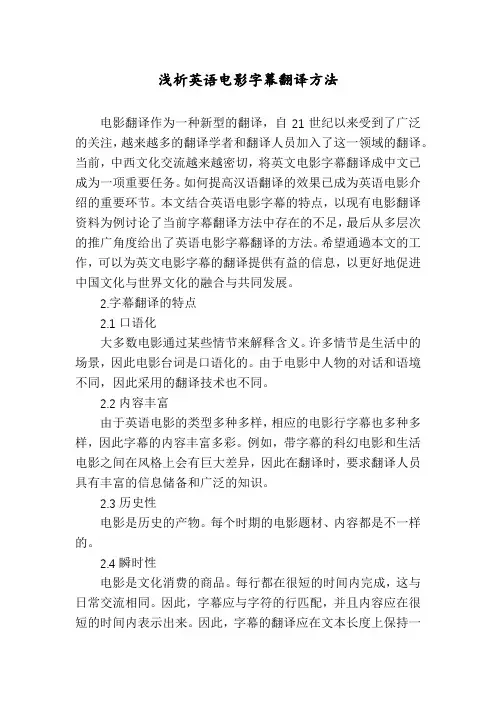
浅析英语电影字幕翻译方法电影翻译作为一种新型的翻译,自21世纪以来受到了广泛的关注,越来越多的翻译学者和翻译人员加入了这一领域的翻译。
当前,中西文化交流越来越密切,将英文电影字幕翻译成中文已成为一项重要任务。
如何提高汉语翻译的效果已成为英语电影介绍的重要环节。
本文结合英语电影字幕的特点,以现有电影翻译资料为例讨论了当前字幕翻译方法中存在的不足,最后从多层次的推广角度给出了英语电影字幕翻译的方法。
希望通過本文的工作,可以为英文电影字幕的翻译提供有益的信息,以更好地促进中国文化与世界文化的融合与共同发展。
2.字幕翻译的特点2.1口语化大多数电影通过某些情节来解释含义。
许多情节是生活中的场景,因此电影台词是口语化的。
由于电影中人物的对话和语境不同,因此采用的翻译技术也不同。
2.2内容丰富由于英语电影的类型多种多样,相应的电影行字幕也多种多样,因此字幕的内容丰富多彩。
例如,带字幕的科幻电影和生活电影之间在风格上会有巨大差异,因此在翻译时,要求翻译人员具有丰富的信息储备和广泛的知识。
2.3历史性电影是历史的产物。
每个时期的电影题材、内容都是不一样的。
2.4瞬时性电影是文化消费的商品。
每行都在很短的时间内完成,这与日常交流相同。
因此,字幕应与字符的行匹配,并且内容应在很短的时间内表示出来。
因此,字幕的翻译应在文本长度上保持一致,而内容应更加一致。
2.5合理性电影是时代的艺术品,所以它应该顺应时代的特征,与时俱进,顺应时代的背景,才可以顺应思想时代的主流,所以达到流传经典的水平。
作为表达电影意义的主要方式,台词承担了主要任务。
经典系列可以生存很长时间,而不太受欢迎的系列则很快就被遗忘了。
这样,字幕翻译就显得尤为重要,因为看电影的人只能通过字幕翻译后的语言来理解每一行字符的内容。
如果字幕翻译没有传达正确的含义,那么上电影的人会感到困惑,因为他们不了解电影讲话的内容。
如果电影没有被观众所理解,更不用说警告甚至传播给人们了。
英文电影字幕翻译分析
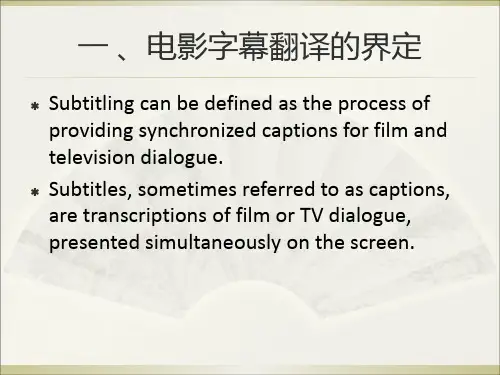
Everything you see exists together in a delicate balance.
世界上所有的生命都在微妙的平衡中生存。(狮子王)
I laugh in the face of danger.
越危险就越合我心意。(狮子王)
God shall wipe away all the tears from their eyes, and there shall be no more death. Neither shall there be sorrow or dying, neither shall there be any more pain, for the former world has passed away.
Minoritizing Translation (异化翻译法)
《功夫》: 洪家铁线拳——Iron Fist from the Hung School 昆仑派的蛤蟆功——The Toad Style of Kwan Lun School 虎行——Tiger style 《功夫熊猫》: 师傅——Master Shifu 乌龟大师——Master Oogway
Is this a slaughter house? 莫非是一家黑店?
Should I show you my heart? 要不要我把心掏出来给你看看啊?
If I can’t be with the one who I love, I won’t be happy even if I were Heaven Emperor. 如果不能跟我喜欢的人在一起,就算让我做玉皇大帝我也 不会开心。
“pigeon”指鸽子,在中文中没有什么不好的意思,但在 英语俚语中有“傻瓜,受骗上当者”的意思。
浅析英语字幕翻译策略
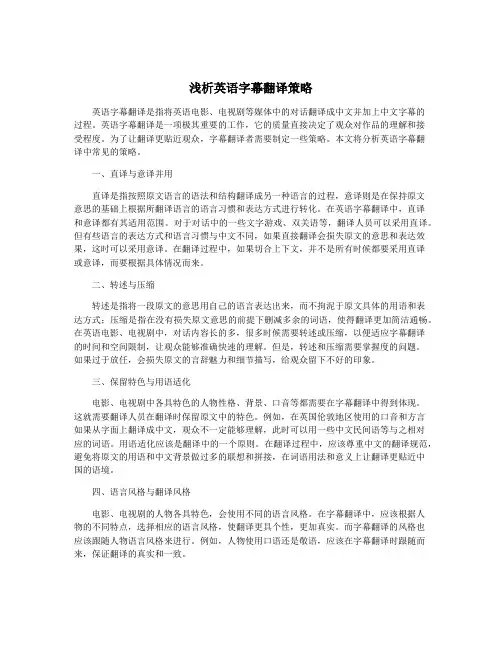
浅析英语字幕翻译策略英语字幕翻译是指将英语电影、电视剧等媒体中的对话翻译成中文并加上中文字幕的过程。
英语字幕翻译是一项极其重要的工作,它的质量直接决定了观众对作品的理解和接受程度。
为了让翻译更贴近观众,字幕翻译者需要制定一些策略。
本文将分析英语字幕翻译中常见的策略。
一、直译与意译并用直译是指按照原文语言的语法和结构翻译成另一种语言的过程,意译则是在保持原文意思的基础上根据所翻译语言的语言习惯和表达方式进行转化。
在英语字幕翻译中,直译和意译都有其适用范围。
对于对话中的一些文字游戏、双关语等,翻译人员可以采用直译。
但有些语言的表达方式和语言习惯与中文不同,如果直接翻译会损失原文的意思和表达效果,这时可以采用意译。
在翻译过程中,如果切合上下文,并不是所有时候都要采用直译或意译,而要根据具体情况而来。
二、转述与压缩转述是指将一段原文的意思用自己的语言表达出来,而不拘泥于原文具体的用语和表达方式;压缩是指在没有损失原文意思的前提下删减多余的词语,使得翻译更加简洁通畅。
在英语电影、电视剧中,对话内容长的多,很多时候需要转述或压缩,以便适应字幕翻译的时间和空间限制,让观众能够准确快速的理解。
但是,转述和压缩需要掌握度的问题。
如果过于放任,会损失原文的言辞魅力和细节描写,给观众留下不好的印象。
三、保留特色与用语适化电影、电视剧中各具特色的人物性格、背景、口音等都需要在字幕翻译中得到体现。
这就需要翻译人员在翻译时保留原文中的特色。
例如,在英国伦敦地区使用的口音和方言如果从字面上翻译成中文,观众不一定能够理解,此时可以用一些中文民间语等与之相对应的词语。
用语适化应该是翻译中的一个原则。
在翻译过程中,应该尊重中文的翻译规范,避免将原文的用语和中文背景做过多的联想和拼接,在词语用法和意义上让翻译更贴近中国的语境。
四、语言风格与翻译风格电影、电视剧的人物各具特色,会使用不同的语言风格。
在字幕翻译中,应该根据人物的不同特点,选择相应的语言风格,使翻译更具个性,更加真实。
从目的论角度浅谈电影英语字幕翻译
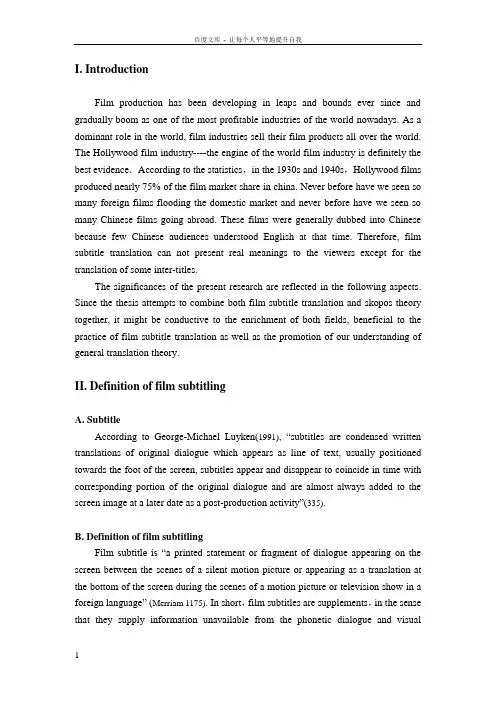
I. IntroductionFilm production has been developing in leaps and bounds ever since and gradually boom as one of the most profitable industries of the world nowadays. As a dominant role in the world, film industries sell their film products all over the world. The Hollywood film industry----the engine of the world film industry is definitely the best evidence.According to the statistics,in the 1930s and 1940s,Hollywood films produced nearly 75% of the film market share in china. Never before have we seen so many foreign films flooding the domestic market and never before have we seen so many Chinese films going abroad. These films were generally dubbed into Chinese because few Chinese audiences understood English at that time. Therefore, film subtitle translation can not present real meanings to the viewers except for the translation of some inter-titles.The significances of the present research are reflected in the following aspects. Since the thesis attempts to combine both film subtitle translation and skopos theory together, it might be conductive to the enrichment of both fields, beneficial to the practice of film subtitle translation as well as the promotion of our understanding of general translation theory.II. Definition of film subtitlingA. SubtitleAccording to George-Michael Luyken(1991), “subtitles are condensed written translations of original dialogue which appears as line of text, usually positioned towards the foot of the screen, subtitles appear and disappear to coincide in time with corresponding portion of the original dialogue and are almost always added to the screen image at a later date as a post-production activity”(335).B. Definition of film subtitlingFilm subtitle is “a printed statement or fragment of dialogue appearing on the screen between the scenes of a silent motion picture or appearing as a translation at the bottom of the screen during the scenes of a motion picture or television show in a foreign language” (Merriam 1175). In short,film subtitles are supplements,in the sense that they supply information unavailable from the phonetic dialogue and visualpicture.Film subtitles are different from “displays” or “captions”. “Displays” are “fragments of text recorded by the camera-letters, newspapers, headlines, banners etc” (Gottlieb l01-121). “Captions” (or “top titles”) are pieces of “textual information usually inserted by the program maker to identify names,places or dates relevant to the story line”(Luyken). This distinction is maintained here and “subtitles”do not include displays or captions, unless otherwise stated.Film subtitle can be both “intralingual”(and “vertical”), when the target language is the same as the source language, and “intralingual” (or “diagonal”), when the target language is different from the source language (Gottlieb 249-258). “Film subtitle”in this thesis is used to refer to interlingual film subtitle, unless otherwise stated.Film subtitle can be “open”, when the target text constitutes a physical part of the translated film and is transmitted together with the film sound and image,or “closed”, when the target text is stored in a digital/teletext format which is transmitted in as well as accessed via a separately coded channel at the discretion of the viewers(Gottlieb 247). In this thesis, “film subtitle”, refers to open film subtitle, unless otherwise stated.III. A brief introduction to skopostheorieA. The process of skoposSkopos is the Greek word for “aim” or “purpose” and was induced into translation theory in the 1970s by Hans J. Vermeer as a technical term for the purpose of a translation and of the action of translating skopos focuses on the purpose of the translation, which determines the translation methods and strategies that are to be employed in order to produce a functionally adequate result, the target text (TT), called the translatum by Vermeer (20-23). Therefore,in skopos theory,knowing why an source text (ST) is to be translated and what the function of the TT will be are crucial for the translator.In the 1970s there appeared a school in translation studies in Germany functionalism. Katharina Reiss firstly pointed out in his work Translation Criticism (2004). The representatives are Katharina Reiss, Hans J. Vermeer and Christiane Nord. They hold that translation is a kind of action with a purpose. This theory is first presented by Reiss and Vermeer in their book Grundlegung einer allgemeinen Translationstheorie (1984) (General Foundations of Translation Theory).Since 1978, German translation theorist H. J. Venneer, who breaks through thetraditional equivalence-based the theory that centers on source text,creates the skopostheories with the translation purpose or function of a translation as a general principle on the basis of theory of action(23-24). It is generally agreed now that translation is a type of human action. According to Vermeer, human action is intentional and purposeful behavior that takes place in a given situation, which modifies the situation at the same time (205-210). Skopos argues that the shape of target text should above all be determined by the function or “Skopos”that it is intended to fulfill in the target context.Vermeer believes that the purpose of a target text determines the translation strategies. In his opinion, the purpose of a target text, which is so important, is great extent decided by target readers, cultural background. In Hans J Vemeer’s Skopos and Commission in Translational Action(1989),Vemmer puts the Skopostheorie in this way:“Any form of translation action, including therefore translation itself, maybe conceived as an action, as the name implies. Any action has an aim, a purpose. The word Skopos, then, is a technical term for the aim or purpose of a translation.” In her book Translating as a Purposeful Activity: Functionalist Approaches Explained (2001), Christiane Nord defines the skopostheorie that “Skopos is a Greek word for purpose”(13-14). According to skopostheorie (the theory that applies the notion of Skopos to translation), the prime principle determining any translation process is the purpose (skopos) of the overall translational action. This fits in with intentionality being part of the very definition of any action.B. Three rules of the SkopostheorieSkopos theory involves three rules, i. e. skopos rule, coherence rule and fidelity rule, which will be discussed as follows.1. Skopos ruleVermeer postulates that as a general rule it must be the intended purpose of the target text that determines translation methods and strategies. From this postulate, he derives the skopos rule: Human action(and its subcategory:translation) is determined by its purpose(Skopos), and therefore it is a function of its purpose(Baker 236).Vermeer explains the Skopos rule in the following way,“Each text is produced for a given purpose and sho uld serve this purpose. The skopos rule thus reads as follows: translate/interpret/speak/write in a way that enables your text/translation to function in the situation in which it is used and withthe people who want to use it and precisely in the way they want it to function” (29).It is also pointed out that most translational actions allow a variety of skopos, which may be related to each other in a hierarchical order, and the translator should be able to justify their choice of a particular skopos in a given translational situation in translation, ., the skopos must be decided separately in each specific case.Skopos rule helps the translator solve the eternal dilemmas of free vs. faithful translation, dynamic vs. formal equivalence, and so on. Nord points out that the skopos of a particular translation task may require a “free” or a “faithful” translation, or anything between these two extremes, depending on the purpose for which the translation is needed. (29).2. The coherence ruleTwo further general rules are the coherence rule and the fidelity rule. The coherence rule stipulates that the target text must be sufficiently coherent to allow the intended users to comprehend it, given their assumed background knowledge and situational circumstances.The coherence rule, or in Vermeer’s terms, the standard of “intra-textual coherence” means “the receiver should be able to understand it: it should make sense in the communicative situation and culture in which it is received”(Nord 32). The coherence rule specifies that “a t ranslation should be acceptable in a sense that it is coherent with the receivers’ situation” (Nord 32).That is to say, the translator’s task is to produce a text that is at least likely to be meaningful to target-culture receivers, namely, to be coherent with the receivers’situation and thus to be understood by the receivers. Only when the receivers understand it as being sufficiently coherent with their situation, can this communicative interaction be regarded as successful.3. The fidelity ruleHowever, just being coherent with the target situation is not enough. A translation is an offer of information about a preceding offer of information; therefore there is a relationship between the translation and the source text. Vermeer calls this relationship “inter-textual coherence or “fidelity”. This is postulated as a further principle, referred to as the “fidelity rule” (Nord 32)“Inter-textual coherence should exist between source and target text, while the form it takes depends both on t he translator’s interpretation of the source text and on the translation skopos” (Nord 1-32). For example, one possible kind of inter-textualcoherence could be a maximally faithful imitation of the source text.We know that the source text is intended for the source culture receivers instead of translation,therefore when it is translated for the different target-culture recipients, maybe the function of the target text or the purpose of the translation is different from that of the source text. In this case,the “fidelity rule” should give way to the skopos rule. However, the translator should aim for any possible compatibility between the skopos and inter-textual coherence.The three basic rules of the skopostheorie are designed to govern the translator’s activities in the whole translation process. In most cases, due to the reason that the skopos of the translation is frequently likely to deviate from the intention of the corresponding source language text, a translation cannot satisfy the three rules at the same time.IV. Film subtitle translation of If You Are the One from the perspective of skopostheorieIn subtitle translation of If You Are the One, in particular, its skopos is determined by the intention of its director as the initiator and the expectation of the English speaking viewers as the receivers of the English subtitles; its shape is determined by its skopos and the subtitler. This part is to analyze how the factors mentioned above determine the skopos and shape of translated subtitles in If You Are the One, and how strategies are employed to fulfill its skopos.A. Brief review of the film If You Are the OneThe film for 2008, If You Are the One, stars Feng’s longtime collaborator, Ge You, as a man in his 40s, newly rich, looking to settle down and start a family. Having made an instant fortune through his sale of the Conflict Resolution Terminal 2008, middle-aged entrepreneur Qin Fen (Ge You) turns his attention to finding a wife. Using all online personals service, he auditions potential spouses, but few make a lasting impression. Qin Fen’s stalwart personality is partly to blame;he’s intent on finding a suitable match,and is willing to walk away from even an absolute goddess if there’s a hint of incompatibility. So it goes with comely flight attendant Smiley Liang (Shu Qi), who Qin Fen initially recognizes as a poor match. Regardless, the two commiserate over drinks, where the melancholy Smiley reveals that she’s dating amarried man (Alex Fong). The two parts intends never to meet again, with each returning to their own pursuit of love.But as fate and the screenwriters would have it, Qin Fen and Smiley meet again on all airline flight,with Smiley working, Qin Fen traveling, and Smiley’s boyfriend and wife also present. The coincidence draws Qin Fen and Smiley back together, propelling them on the road to friendship and perhaps more, with occasional stops at fine luxury entertainment locations, where they sip expensive drinks while verbally sparring over their views on love. Qin Fen aims for a home run with his potential mate, while Smiley seems willing to settle if she can’t have her idealized,unattainable love. In response, Qin Fen tries to convince her otherwise while attempting not to appear as he’s trying to. It’s the story of one man’s tough love, except with a picturesque tour of fabulous locations that only people with money can visit. Somewhere in there, Qin Fen’s loyalty and stalwart affection is supposed to comfort Smiley’s wounded heart or something like that.B. An analysis of subtitle translation of If You Are the One based on skoposIn subtitle translation of If You Are the One, in particular, its skopos is determined by the intention of its director Feng Xiaogang as the initiator and the expectation of the English-speaking viewers as the receivers of the English subtitles; its shape is determined by its skopos and the subtitler. This part is to analyze how the factors mentioned above determine the skopos and shape of translated subtitles in If You Are the One and how the strategies are employed to fulfill its skopos.1. Feng Xiaogang’s intentionFeng never denies his wish to defeat the Hollywood films at the box office by adapting Hollywood’s game rules (Rosen 336).Feng discloses that the Associate President of Columbia Pictures, once said to him, “Your films have never been shown in overseas countries and thus you are not known to the viewers outside your country.Big Shot’s Funeral serves as an advertisement to publicize you and I hope it can provide the foundation for your second and third film in the overseas market” (Feng 187). From Mr. Geris’s wish, we can also find F eng’s ambition to gain the market share in foreign countries. And the film If You Are the One has proved to be well received in the North American market.Feng recalls in his book that on a seminar about the making of Big Shot’s Funeral,some people asked him whether the production strategy of the film should beconsidered as Hollywood’s cultural invasion into Chinese film industry. He replies that “it is a win-win deal and a two-edged sword” and that this kind of cooperation is cost-efficient because it “still makes Chinese films,but faces the global market” (Feng 187). As for Feng Xiaogang, the way to revive domestic market and march into international market is to cooperate with foreign film production companies and internationalize domestic film success.From above,we can see that the director’s intention is to bridge the gap between Chinese and foreign cultures and gain market share in foreign countries,which is the major part of translation brief.2.Skopos analysisTo define the skopos, we should verify the translation brief. Although it is said that a brief should be given by the clients, more often than not, it is not the case. Then a translator should have the ability to verify it by himself. The translation brief of the present case could be specified as follows:a. The intended text functions: the main function of the TT is referential. If You Are the One is more a commercial movie than art,the intended text function is first of all referential, to provide information about what is going on the screen. Then it may come the expressive function to relay the sender’s attitude and feelings. The translator must weigh against different functions and decide on the main one. In the present case,it is the referential function that wins the upper hand. Translator has to make a choice according to the skopos of the translation of film subtitle. Feng’s film subtitle translation aims to win the target market so that translator has to produce clear and concise subtitled film dialogues bridging the cultural gaps and make the narrative easily accessible for the audience.Thus, the target audience will find it easier to accept and understand the translated subtitles. Here are some examples.(1)秦奋:不算老实但天生胆小I'm no angel杀人不犯法我也下不去手Just too cowardly to do wrongThe west and east have different religious beliefs. In Christianity, Angel is a good spirit who is kind, lovely and innocent. Here, Qin Fen describes himself as a man who is not well-behaved.So he is not like an angel.(2)别猫哭耗子了Spare me the alligator tearsIn China, there is a proverb“猫哭耗子假慈悲”. This means the cat pretends to be sympathetic to the death of the mouse because she can have it as a meal. In western culture, people think that while having meals, usually an animal, an alligator will shed tears. So alligator tears implies disguised sympathy.(3)有的人是情人眼里才是西施Beauty is in the eyes of the beholder不过分的说, 仇人眼里你都是西施But no exaggeration, even to a foe,you’d be beautifulThe above underlined words or proverbs are all culture-loaded. Domestication is adopted to make the western audience fully understand the film.b. The addressees:It is self-evident that the TT addressees in subtitle translation are the foreign audience, probably adults, who share a different culture background and who are lay of Chinese. To be specific, they are common people who watch it for entertainment and film festival juries who view it with a discerning eye, eg.秦奋:那咱俩要是结婚了So,if we get married非得倒插门我去你们那儿吗I have to go to live with your family?In China, in most cases,after marriage, the wife lives with the husband’s family. “倒插门”means the husband lives with wife’s family. In this sentence, it is deleted since it expresses the same meaning as “我去你们那儿”.c. The time and place of text reception: The time and space of reception is less controversial,which vary in different cases. In this case, the time is up to now from 2008 when it was released to the public and the place is at the very beginning cinema and later on amounts to a wide range of places thanks to the development of technologies such as DVD.So far, the skopos of the translation can be defined as to supplement the film by providing the optimal information for the audience in written form within a limited time and space.V. Film subtitle translation of Curse of the Golden Flower from the perspective of skopostheorieIn this part, the subtitle translation of Curse of the Golden Flower is analyzedwith the background of the skopos theory.A. Background of Curse of the Golden FlowerCurse of the Golden Flower is derived from the story Thunderstorm, one of the best-known masterpieces by the most famous Chinese playwright Cao Yu. But the adaptation doesn’t stay too faithful to the original. The film is a historical drama directed by Zhang Yimou who also co-wrote the screenplay in Chinese. The screen version is established in the 10th century during the short-1ived Late Tang Dynasty, about a thousand years ago.For today’s viewers,it is a story about court intrigues and deceptions. Moreover there are several pivotal factors within the plot, among which, traditional Chinese medicine is the foremost one since the Emperor in the film is gradually poisoning his wife, the Empress, by adding a deadly fungus to her medicine. Zhang Yimou the director gives his explanation of the arrangement that “as for the Emperor’s personality, well, he’d love to stay in the royal pharmacy all the time. He’s a drug freak. That’s how his character is developed and expanded upon. He’s just so into the drug”.B. An analysis of subtitle translation of Curse of the Golden Flower based onskoposThe title of the movie,which is literally translated as “The Whole City is Clothed in Golden Armor”, is the last line taken from a Tang Dynasty poem---Do not Endow with Chrysanthemum Behind written by Huang Chao who rose in rebellion in 875 and died 9 years later.After changing the title several times, the screenwriters as well as the director finally settle on the poem for the reason that it indicates the rebellion taken by the Prince against the Emperor in the movie. The Chinese audience may easily understand the cultural connotation while the English-speaking audience who are not familiar with the background of the poem, due to the great disparity in terms of cultural background, may not comprehend the implicit aspects of the title without the explanatory message or footnote. Consequently, this kind of culturally loaded expressions will put a lot of processing efforts on the target audience. In addition, with the constraints of time and space, if they focus on the reading of the subtitle, they will lose some of the visual and audio information.To solve this problem, the subtitler discards the Chinese title and adapts a new one with the image of the golden flower taken as a symbol to reveal the palace intrigue and the machination of power play to the target audience. The golden flower is designed to function as the symbol of rebellion, which is the same as the title. Hence its images appearing in the film once and again will, in another form, retrieve the loss of the culturally loaded information caused by the substitution since film is a multidimensional art involving visual images, sound, colors and so on. Let’s see some examples:(1)辰时的药煎好了Your Majesty’s medicine for the hour is ready(2)执令官统领后宫羽林军The Imperial Guards protect our private palacesIt is no easy job to translate cultural elements in subtitle translating. The underlined parts of the source text are omitted in the target text since these cultural elements do not deliver adequate information and there is no time to explain all details. Their function can be retrieved by the image and the subtitler is careful enough not to omit information that could at a later stage be essential for the understanding of the story.According to adequacy and equivalence theory, the translator can not offer the same amount and kind of information as the source-text producer. What the translator does is to offer another kind of information in another form (Reiss & Vermeer 123). Located in a broader ecological culture, the subtitling succeeds in producing a communicative interaction in the target text. We may find another example in this film:(3)当年你只是一个小小的都尉At that time,you were only a lowly captain.“都尉”here refers to the low-ranking officer in Tang Dynasty. If a simple transliteration as “Duwei”is adopted, it is completely meaningless to the English-speaking audience and fails to achieve intra-textual coherence. Whether to translate the complete meaning of “Duwei”, on the other hand, makes no difference to the comprehension of the plot for the source text producer just means that the Emperor mounts the throne from the bottom. Therefore the subtitler, by chunking it up, translates it into “a lowly captain” to establish inter-textual coherence as well as intra-textual coherence in the target text.(4)儿臣为了母后从此不再服药You will never drink the poison again.In the film, what the Empress drinks is a kind of Chinese medicine containing the ingredient that will cause a person to lose his or her entire mental faculty. According to traditional Chinese medicine, any medicine has 30% poison ingredients. Therefore some ingredients are useful as well as poisonous. Their curative value is restricted to certain diseases and certain dosage based on the theory of using poison to cure poison. These ingredients belong to the category of medicine despite of their toxicity. By chunking down the medicine into poison, the subtitler defines the meaning in the narrowest sense and makes the implicit information explicit to accomplish intra-textual coherence in the target text.VI. ConclusionA. ContributionSkopostheorie provides translators with a whole new perspective into translation action. This paper conducts a systematic analysis of crucial factors that influence the strategies of subtitle translation, in which skopostheorie is adopted to guide the descriptive and explanatory analysis.On the basis of the above analysis, this paper gets some enlightenment of skopostheorie on subtitle translation. The enlightenment of “intra-textual coherence”on subtitle translating is that the target receiver should be able to understand the translated version of subtitle. And the translated version should make sense in the communicative situation and culture in which it is received. The subtitler should always keep the target viewers in mind. After exploring the main components of skopostheorie and analyzing the specific constraints in film subtitle translation, the author tries to find out some enlightenment of skopostheorie on subtitle translation. In order to find out the enlightenment, this paper analyzes Feng Xiaogang’s film in light of skopostheorie. The film If You Are the One proves to be successful in its target market. Therefore, this paper tries to find out influencing factors that affect the subtitler’s choice of strategies.The author gives focus to the skopos of subtitle translation, the more influencing role of the film director in subtitle translation and the importance of target audience. With reference to skopostheorie,subtitle translating is a purposeful activity and thepurpose of the whole translational action is the prime principle that determines the translation process. The basic purpose or skopos of subtitle translation is to aid the viewers with a translated film dialogue, to provide them with the most relevant information in the most effective way within its specific constraints,to help them in understanding what’s happening on the screen with ease.B. LimitationsOwing to the limitations of time and space,the source data collected for the thesis is limited. Meanwhile because of the knowledge limitations this paper can not deeply analyzes the translation of Chinese film subtitles into English ones from the perspective of skopostheorie. It is the author’s sincere wish that if possible, in the future, further research can be done on comparative study on Chinese-English translation and English-Chinese translalion of film subtitles.Work CitedBaker, Mona. Routledge Encyclopeata of Translation Studies. Shanghai:Shanghai Foreign Language Education Press(2004):Baker,Christiane, Nord. Translating as a Purposeful Activity: Functional Approaches Explained.Shanghai: Shanghai Foreign Language Education Press, 2001.Feng, X. G[冯小刚]我把青春献给你武汉:长江文艺出版社2003: 187Gottlieb, H. Teaching Translation and Interpreting. Amsterdam: John Benjamins Publishing Company, 1998Gottlieb, H. Media Translation. Amsterdam/Philadelphia: John Benjamins Publishing Company, 2001Gottlieb, H. Subtitfing: Diagonal translation In C. Dollerup et al. (eds), Perspectives Studies in Translatology. Copenhagen: University of Cpenhagen, 1994 l01-121.Gottlieb, H. Anglicisms and TV Subtitles in an Anglified World: [A] Gambier Yves, 249-258 Gottlieb, H.Subtitling-a new university discipline in Teaching Translating and Interpreting. (eds) Dollerup, Cay&A. . Amsterdam: John Benjamin. 1998: 247Katharina, Reiss. Translation Criticism: The Potentials&Limitations. Shanghai: Shanghai Foreign Language Education Press, 2004.Katharina, Reiss and Hans J. Vermeer. Grundlegung einer allgemeinen Translationstheorie.Tubingen:Niemeyer, 1984,Michael. Overcoming Language Barriers in Television. [M] Manchester: European Institute forthe Media 1991.Luyken,George-Michael. Overcoming Language Barriers in Television. [M] Manchester: European Institute for the Media 1991.Merriam-Webster. Merriam Webster's Collegiate Dictionary. 1997:1175Rosen,S.(2002).狼来了:好莱坞与中国电影市场,. 全球化与中国影视的命运336-360. (S.Y Sun, Trans.). Shanghai: Shanghai Foreign Language Education Press. 1994-2000 Vermeer, Hans J. Skopos and Commission in Translational Action in Chesterman(ed). 1989, 20-233.。
英文电影字幕的翻译方法与技巧
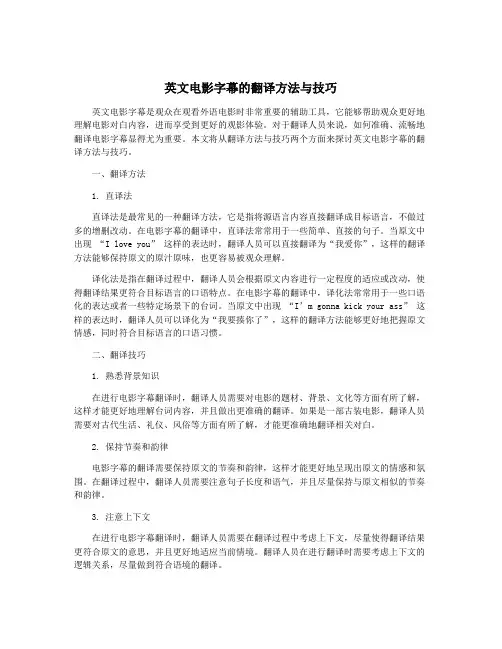
英文电影字幕的翻译方法与技巧英文电影字幕是观众在观看外语电影时非常重要的辅助工具,它能够帮助观众更好地理解电影对白内容,进而享受到更好的观影体验。
对于翻译人员来说,如何准确、流畅地翻译电影字幕显得尤为重要。
本文将从翻译方法与技巧两个方面来探讨英文电影字幕的翻译方法与技巧。
一、翻译方法1. 直译法直译法是最常见的一种翻译方法,它是指将源语言内容直接翻译成目标语言,不做过多的增删改动。
在电影字幕的翻译中,直译法常常用于一些简单、直接的句子。
当原文中出现“I love you” 这样的表达时,翻译人员可以直接翻译为“我爱你”,这样的翻译方法能够保持原文的原汁原味,也更容易被观众理解。
译化法是指在翻译过程中,翻译人员会根据原文内容进行一定程度的适应或改动,使得翻译结果更符合目标语言的口语特点。
在电影字幕的翻译中,译化法常常用于一些口语化的表达或者一些特定场景下的台词。
当原文中出现“I’m gonna kick your ass” 这样的表达时,翻译人员可以译化为“我要揍你了”,这样的翻译方法能够更好地把握原文情感,同时符合目标语言的口语习惯。
二、翻译技巧1. 熟悉背景知识在进行电影字幕翻译时,翻译人员需要对电影的题材、背景、文化等方面有所了解,这样才能更好地理解台词内容,并且做出更准确的翻译。
如果是一部古装电影,翻译人员需要对古代生活、礼仪、风俗等方面有所了解,才能更准确地翻译相关对白。
2. 保持节奏和韵律电影字幕的翻译需要保持原文的节奏和韵律,这样才能更好地呈现出原文的情感和氛围。
在翻译过程中,翻译人员需要注意句子长度和语气,并且尽量保持与原文相似的节奏和韵律。
3. 注意上下文在进行电影字幕翻译时,翻译人员需要在翻译过程中考虑上下文,尽量使得翻译结果更符合原文的意思,并且更好地适应当前情境。
翻译人员在进行翻译时需要考虑上下文的逻辑关系,尽量做到符合语境的翻译。
4. 精准表达情感电影是一个感情表达的艺术形式,因此在电影字幕翻译中,翻译人员需要尽量准确地表达原文中蕴含的情感和情绪。
电影字幕翻译的策略——以英文电影汉译为例
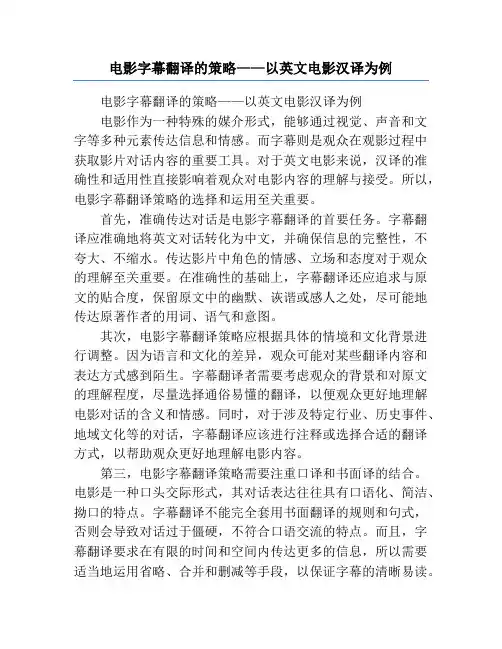
电影字幕翻译的策略——以英文电影汉译为例电影字幕翻译的策略——以英文电影汉译为例电影作为一种特殊的媒介形式,能够通过视觉、声音和文字等多种元素传达信息和情感。
而字幕则是观众在观影过程中获取影片对话内容的重要工具。
对于英文电影来说,汉译的准确性和适用性直接影响着观众对电影内容的理解与接受。
所以,电影字幕翻译策略的选择和运用至关重要。
首先,准确传达对话是电影字幕翻译的首要任务。
字幕翻译应准确地将英文对话转化为中文,并确保信息的完整性,不夸大、不缩水。
传达影片中角色的情感、立场和态度对于观众的理解至关重要。
在准确性的基础上,字幕翻译还应追求与原文的贴合度,保留原文中的幽默、诙谐或感人之处,尽可能地传达原著作者的用词、语气和意图。
其次,电影字幕翻译策略应根据具体的情境和文化背景进行调整。
因为语言和文化的差异,观众可能对某些翻译内容和表达方式感到陌生。
字幕翻译者需要考虑观众的背景和对原文的理解程度,尽量选择通俗易懂的翻译,以便观众更好地理解电影对话的含义和情感。
同时,对于涉及特定行业、历史事件、地域文化等的对话,字幕翻译应该进行注释或选择合适的翻译方式,以帮助观众更好地理解电影内容。
第三,电影字幕翻译策略需要注重口译和书面译的结合。
电影是一种口头交际形式,其对话表达往往具有口语化、简洁、拗口的特点。
字幕翻译不能完全套用书面翻译的规则和句式,否则会导致对话过于僵硬,不符合口语交流的特点。
而且,字幕翻译要求在有限的时间和空间内传达更多的信息,所以需要适当地运用省略、合并和删减等手段,以保证字幕的清晰易读。
最后,字幕翻译还应注重与影片节奏和画面的匹配。
电影是一种视听的艺术,字幕与影片的节奏和画面应该相互协调,增强影片的观赏性和听觉感受。
字幕的长度、颜色、位置等设计都会对观众的观影体验产生直接影响。
字幕翻译在进行类型选择、用词运用和排版时应该与影片的时代背景、故事情节和音乐等要素相匹配,以营造出更加自然和统一的观影环境。
英文电影字幕的翻译方法与技巧
英文电影字幕的翻译方法与技巧英文电影字幕翻译是一项十分重要的工作,因为它可以让观众更好地理解英语语言及文化背景,为英语学习者提供了一个宝贵的学习资源。
下面是一些英文电影字幕翻译的方法与技巧。
1. 翻译原则:1.1准确性电影字幕翻译应该准确反映原版电影对话的意思。
在翻译时,需要尽可能精细地理解原文。
在翻译过程中,译者应该尽可能准确地翻译语言,比如单词、句子、意义等等。
1.2简洁性电影字幕翻译必须简洁、清晰明了。
轻松的阅读材料能够更好地吸引观众的注意力。
在翻译时需要注意文本的分隔符、句型等等,不要切断原文中被分开的句子。
1.3一致性在翻译过程中,重要的是尽量保持字幕翻译的一致性,比如术语、时态、语气等等。
这会让人们更加容易理解翻译内容。
2.字幕翻译技巧(1)在字幕翻译中,需要注意语言的地区差异。
比如,英语中的颜色等术语,美国和英国的术语可能有所不同。
如果你不确定,最好利用网络来查询相关标准词汇表。
(2)使用靠谱的电影翻译软件,比如Subtitles Translator、Avi Subtitle和Subtitle Workshop。
这些软件具备多种功能特点,比如自动翻译,字幕编辑等等,以此提高翻译效率和一致性。
(3)要使用译文,需要与原版电影匹配。
在使用译文时,同时要遵循字幕翻译的标准。
例如,避免使用第二人称,但可以使用“你”代替“他”。
(4)要小心翼翼地处理文化差异。
有些文化差异因为句子的语言文字而导致翻译困难。
这时你可以借鉴经典的翻译,寻求专家的帮助,或采用本地人可以理解的文化差异来翻译。
(5) 在翻译中,注重电影屏幕上的信息与字幕之间的协调。
字幕可以包括镜头、场景、对话和音效。
字幕还应与时长和角色数量保持一致。
特别是在电影语言翻译上,应特别注意时间和人物名字的一致性。
3.最佳实践- 先观看原片,然后开始翻译。
这样,你可以更好地理解电影的内容、剧情、人物等元素,并减少翻译过程中的错误。
- 翻译的同时,建议在每个时间戳上添加注释、像是音效及配角宣发者的备注等等。
浅谈英语电影字幕翻译——以《返老还童》为例
第二卷
第六期
浅谈英语 电影 字幕翻译
— —
以《 返老还童》 为例
郑 洁
( 东师 范大学外 国语 学院 山 东济 南 山
20 1 ) 50 4
【 要 】 随着近几年 来中外文化交流的深入 , 摘 大量 须采取相应的策略。
1口语 策 略 的 外 国影 片被 引介 到 中国 , 娱 乐人 们 眼球 的 同时 , 在 也促 如上文所 说 , 影视作 品的对 白多 以对 白呈现 , 因此在翻译 进着人 们对于影片欣赏水平 能力 的提 高。国外影 片的 引 尽量使 用人们 在生活 中经 常用 进, 也刺激 了另一个新兴领域一 字幕翻译的发展 , 本文 旨 的时候 就必须使译文通俗 易懂 . h r sCa eo jmi o Be 在通过探讨 英语 电影 的字幕特点 ,以期提 出一些翻译策 到 的语 言 表现 。 如 在 影 片 T eCuiu s f na n 略。
一
B  ̄ n中 , . ah r 夸 赞 Q e n 今 夜十分 美丽 动人 的 uo MrWe t s e uei e 时候 , u e i 也 回应他 说 , “ o i’ n l c o re ” Q en e Y u n t os u hy us l a o f 翻译 为“ 你今天也 不赖” 比直接按照字面意 思来 的生活化 的 就 多 。 又 如 ,当他 们 继续 谈 到 M H mb r肘 , ah r a e . We tes对
【 关键词 】 英语 电影 ; 字幕特点 ; 翻译策略
引言 近 年来随着对外文化 交流 的发展 与深入 。 一大 批优 秀的外 国影 片被 引进到中国 。 受到人们的喜爱 。 大量国外影片的引进 . 带动 了英语字幕 翻译需 求的增长 . 然而 , 关于 英语 电影字幕 翻 译的标准始 终未有一个统一的标准 。 由于影视作 品是剧 作者 但 根据 自身生 活的经历或经验创造而成 . 反映 了一定 的社会 文化 背景 。 其语言对 白具有不同于其他文体的显著特点。 因此, 在对 英语电影翻译 时 , 把握住其特点进行翻译。 应 二 英语 电影 字 幕 的 语言 特 点 1口语性 以剧情 为主 的影视作 品一般主要是 靠角色之 间的互动来 展开 情节 . 这种互动一般 以对话 来呈现 。 既然是对话 . 就是生活 中浅显易懂 的日常 口语 , 即简短 、 直接 、 动 . 生 并且含 有较多的 非正式 语及俗语等。 2文化性 著名翻 译 家 Nd i a指 出 : 语言 是文化 的 一部 分 。 任何 文本 的意 义都有直接或间接地反 映一个相应 的文化 。 词语 意义最终 也只 能在相 应的文化 中找到 。 译制片本身就属于艺术的二度创 作, 目的就是 向 目的语 观众介绍 国外文化 . 进民族文化 的发 促
英语电影字幕中的翻译之道
英语电影字幕中的翻译之道图文 / 来源网络很多人喜欢从欧美电影里学习英语,一般国外的电影都是带字幕的,(事实上,不带字幕分分钟想关掉电影。
)由于字幕来源不同,导致的翻译的效果也不同,这里我们收集了一些字幕的翻译句子,首先需要把娃句子的语境。
01.You're cleverer than you look.(选自电影Brave Heart)你真聪明,看不出来/没想到你的脑子还很好使。
短评:字幕翻译是“你比你看上去的聪明一些”,略显生硬。
02.I don't want us to end up enemies.(选自电影Presumed Innocent)我不希望咱们闹翻/我不希望以互相为敌而告终。
短评:电影字幕的译文是“我不希望干掉敌人”。
原文末尾虽然是成语化的简洁,但是根据最佳关联的原则还是可以推理为“闹翻”或“为敌”的译文。
03.I owe you my life.(选自电影The Count of Monte Critsto)我欠你一条命/我这条命是你捡回来的。
短评:电影字幕是“我这条命是你给的”,岂有此理!命乃父母所赐。
原文的功能是致谢。
因此,若译为“我欠你一大笔人情”或“以后用得着我尽管说”也比“给”字句好些。
04. I am in the book business.(选自电影You've Got Mail)我是做图书生意的/我是书商。
短评:电影字幕是“我在书生意里”,一是汉语不地道,观众不知所云;二是没有翻译出原文的功能。
原文是介绍自己的职业,相当于“我是医生/教师”。
其实在很多情况下,我们需要把握翻译句子所在的语境,显得最地道哦~。
浅析英语影视剧字幕翻译-精品文档
浅析英语影视剧字幕翻译-精品文档浅析英语影视剧字幕翻译一.影视剧字幕翻译的基本特征翻译是跨语言、跨文化的交流活动。
将英语影视剧翻译成中文,就像是译者建了一座桥梁,促进中外文化的沟通交流。
本质上,影视剧翻译与其他文本翻译相同,目的都是将源语的意义用译语予以再现。
但影视剧翻译之所以为影视剧翻译,正是基于其特殊性,也就是影视剧字幕翻译的基本特征。
1.1声画统一性首先,字幕翻译不是独立的,我们在欣赏一部影视作品的时候,不仅要看字幕,更重要的是看画面,听声音。
画面、声音、字幕三者是不可分离的统一体。
所以,译者在翻译字幕的时候,要将字幕与故事情节,画面动作,人物特点等要素结合起来,使各要素和谐融为一体。
此外,由于屏幕是有限的,所以译者在翻译字幕的时候也要受到限制,字幕的内容既要表达出说话人的全部内容,也要控制译文的长度,用最简练的语言,传达最准确的信息,以减轻观众的负担,让观众把关注的重点放在画面和情节上,更好地享受影视剧带来的快乐。
1.2文学魅力性观众看剧,就是要放松,投入,享受,作为字幕译者,应该使观众了解基本信息的前提下,获得良好的审美体验。
也就是说,译者的译文要美,要有文学性,要有审美价值,让观众在看了字幕之后能在情感上引发强烈的反应,这种反应能够在人们心中引起喜怒哀乐酸甜苦辣等各种感觉,能让观众对剧情更加投入,对人物有更深刻的体会,因此,字幕翻译的语言文采不可忽视,这一点又与文学翻译相同,所以,译者在翻译字幕时,可以运用文学翻译的理论,充分把握人物性格特点,情景语境,文化语境等要素.二.影视剧字幕翻译批评与赏析2.1动画片《白雪公主》片段1Queen:Take her far into the forest. Find some secludedplace where she can pick wildflowersHuntsman: Yes, Your Majesty.Queen: And there, my faithful huntsman, you will kill her!Huntsman: But Your Majesty, the little Princess!Queen: Silence! You know the penalty if you fail.Huntsman: Yes, Your Majesty.Queen:But to make doubly sure you do not fail,bring back her heart in this.网络译文王后:把她带进森林深处。
- 1、下载文档前请自行甄别文档内容的完整性,平台不提供额外的编辑、内容补充、找答案等附加服务。
- 2、"仅部分预览"的文档,不可在线预览部分如存在完整性等问题,可反馈申请退款(可完整预览的文档不适用该条件!)。
- 3、如文档侵犯您的权益,请联系客服反馈,我们会尽快为您处理(人工客服工作时间:9:00-18:30)。
浅谈英语电影字幕翻译
一、引言
近年来随着对外文化交流的发展与深入,一大批优秀的外国影片被引进到中国,受到人们的喜爱。
大量国外影片的引进,带动了英语字幕翻译需求的增长,然而,关于英语电影字幕翻译的标准始终未有一个统一的标准,但由于影视作品是剧作者根据自身生活的经历或经验创造而成,反映了一定的社会文化背景,其语言对白具有不同于其他文体的显著特点。
因此,在对英语电影翻译时,应把握住其特点进行翻译。
二、英语电影字幕的语言特点
1.口语性
以剧情为主的影视作品一般主要是靠角色之间的互动来展开情节,这种互动一般以对话来呈现。
既然是对话,就是生活中浅显易懂的日常口语,即简短、直接、生动,并且含有较多的非正式语及俗语等。
2.文化性
著名翻译家Nida 指出:语言是文化的一部分,任何文本的意义都有直接或间接地反映一个相应的文化,词语意义最终也只能在相应的文化中找到。
译制片本身就属于艺术的二度创作,目的就是向目的语观众介绍国外文化,促进民族文化的发展。
3.服务性
英语字幕不是独立存在的。
它必须与影视作品的画面、声音等结合在一起才具有意义。
如果把一段字幕抽取出来,单看其内容,是无法了解其真正涵义的,而其最终目的决定了字幕的服务性的特点。
4.时空受限性
既然字幕不可能独立于画面和声音而存在,这也就决定了其在时间停留和空间安排上都受到限制的特点。
一方面,它不可能像书本上的文字一样长久停留在同一处,静止不动。
随着与其语境相吻合的画面和声音的消失,它也必然消失,被下一句字幕所取代,即字幕瞬时性的本质。
另一方面,字幕的空间存在也受到较大限制。
影视剧最大的魅力就在于其图像与声音的完美结合。
字幕作为并非必要的一种后来添加物,其存在的前提便是不能对画面的整体视觉效果造成较大的破坏。
因此,字幕的排版也必须符合审美标准。
三、字幕翻译常用方法
1.直译法
由于不同国家的文化在大多数情况下是重叠的,所以原语言观众和目的语观众有相同或
相似的认知环境。
在没有出现文化差异的情况下,直译足够帮助目的语观众获得最佳关联。
据统计,一部电影或是电视剧,至少有百分之七十的内容可以用直译来处理。
2.替代法
英语和汉语是不同的两种语言,在文化背景不同的情况下,原语言中的语境效果在目的语中就会流失。
这个时候,直译就不能将原语言话语的真实信息和交际意图都传递给目的语观众,目的语观众因此得不到最佳关联。
于是,就需要找到一个能够在目的语中产生与原语言中相同语境效果的替代表达方式。
翻译的替代方法,被广泛用于影视剧中出现谚语、习语、俚语的场合。
如:You know the old saying,don't you?In for an inch, in for a mile.(你知道那句老话吧?得寸进尺。
)这里所回答的是个英语的谚语,表示人在受到好处时不知足,而有更多要求。
如果直译,目的语观众就会不理解说话者要表达的意思,译者用汉语的成语得寸进尺来替代,既传达了原语言的意思,也从语言结构上最大程度保留了原语言的特点,目的语观众因此得到最佳关联。
再如You can still put the brakes on this thing,其中put the brakes on this thing是英语的习惯表达,表示一个人做了错事,还有机会为其弥补。
如果直译,原文的意思能够传达给目的语观众,但英语的这种习惯表达的语言结构就流失了。
译者选用一个具有习语功用的汉语成语亡羊补牢,为时不晚来替代,从而使目的语观众得到最佳关联。
3.增译法
增译就是译者在直译的基础上加上一些信息,以帮助目的语观众理解原语言的意思。
由于文化上的差异,当原语言中的互明在目的语中丢失时,增译能够帮助目的语观众得到丢失的互明,减少处理的努力,从而得到最佳关联。
原语言的文化内涵在目的语中能找到相关的信息,然而大部分目的语观众对此不熟悉,这时增译就是最好的解决方法。
例如:Sucre-Forget it. The guy's a boy scout(算了吧,他是一个童子军意指听话,遵守纪律)。
a boy scout 是童子军的意思,大多数人知道童子军,但不知道它代表的真正含义。
译者增加了一些信息(意指听话,遵守纪律),从而帮助目的语观众理解原语言的信息和交际意图。
再如Sucre-a cellphone in here?(把手机藏在这里?)Thats cardinal sin Number 1(你这是犯了七宗罪之首意为自大)。
对于cardinal sin Number 1,在汉语中能找到相关信息,意为七宗罪中的第一宗罪,但大多数人对这第一宗罪是什么并不清楚,于是,原语言观众得到的互明在目的语观众中很可能会流失。
这时,译者采用增译,就可帮助目的语观众理解说话者的真正意图。
四、结语
字幕翻译由于其自身的特殊性,因此在对外文影片进行翻译时必须具体问题具体分析,采取适当的翻译策略。
影视翻译作为翻译研究的一个领域,虽然目前并未得到学术界足够的重视和关注,但相信随着文化交流的日益深入,其发展也会日臻完善。
